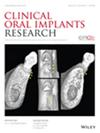Anatomically Based Multitask Deep Learning Radiomics Nomogram Predicts the Implant Failure Risk in Sinus Floor Elevation.
IF 5.3
1区 医学
Q1 DENTISTRY, ORAL SURGERY & MEDICINE
引用次数: 0
Abstract
OBJECTIVES To develop and assess the performance of an anatomically based multitask deep learning radiomics nomogram (AMDRN) system to predict implant failure risk before maxillary sinus floor elevation (MSFE) while incorporating automated segmentation of key anatomical structures. MATERIALS AND METHODS We retrospectively collected patients' preoperative cone beam computed tomography (CBCT) images and electronic medical records (EMRs). First, the nn-UNet v2 model was optimized to segment the maxillary sinus (MS), Schneiderian membrane (SM), and residual alveolar bone (RAB). Based on the segmentation mask, a deep learning model (3D-Attention-ResNet) and a radiomics model were developed to extract 3D features from CBCT scans, generating the DL Score, and Rad Score. Significant clinical features were also extracted from EMRs to build a clinical model. These components were then integrated using logistic regression (LR) to create the AMDRN model, which includes a visualization module to support clinical decision-making. RESULTS Segmentation results for MS, RAB, and SM achieved high DICE coefficients on the test set, with values of 99.50% ± 0.84%, 92.53% ± 3.78%, and 91.58% ± 7.16%, respectively. On an independent test set, the Clinical model, Radiomics model, 3D-DL model, and AMDRN model achieved prediction accuracies of 60%, 76%, 82%, and 90%, respectively, with AMDRN achieving the highest AUC of 93%. CONCLUSION The AMDRN system enables efficient preoperative prediction of implant failure risk in MSFE and accurate segmentation of critical anatomical structures, supporting personalized treatment planning and clinical risk management.基于解剖学的多任务深度学习放射组学图预测窦底抬高的种植失败风险。
目的:开发并评估基于解剖学的多任务深度学习放射组学(AMDRN)系统的性能,该系统在颌骨窦底抬高(MSFE)前预测种植体失败风险,同时结合关键解剖结构的自动分割。材料与方法回顾性收集患者术前锥形束计算机断层扫描(CBCT)图像和电子病历(emr)。首先,优化nn-UNet v2模型,分割上颌窦(MS)、施耐德膜(SM)和残余牙槽骨(RAB)。基于分割掩码,开发了深度学习模型(3D- attention - resnet)和放射组学模型,从CBCT扫描中提取3D特征,生成DL评分和Rad评分。从emr中提取重要的临床特征,建立临床模型。然后使用逻辑回归(LR)将这些组件集成以创建AMDRN模型,该模型包括支持临床决策的可视化模块。结果MS、RAB和SM的分割结果在测试集上获得了较高的DICE系数,分别为99.50%±0.84%、92.53%±3.78%和91.58%±7.16%。在独立测试集上,临床模型、放射组学模型、3D-DL模型和AMDRN模型的预测准确率分别为60%、76%、82%和90%,其中AMDRN模型的AUC最高,为93%。结论AMDRN系统能够有效预测MSFE种植体失效风险,准确分割关键解剖结构,支持个性化治疗计划和临床风险管理。
本文章由计算机程序翻译,如有差异,请以英文原文为准。
求助全文
约1分钟内获得全文
求助全文
来源期刊

Clinical Oral Implants Research
医学-工程:生物医学
CiteScore
7.70
自引率
11.60%
发文量
149
审稿时长
3 months
期刊介绍:
Clinical Oral Implants Research conveys scientific progress in the field of implant dentistry and its related areas to clinicians, teachers and researchers concerned with the application of this information for the benefit of patients in need of oral implants. The journal addresses itself to clinicians, general practitioners, periodontists, oral and maxillofacial surgeons and prosthodontists, as well as to teachers, academicians and scholars involved in the education of professionals and in the scientific promotion of the field of implant dentistry.
 求助内容:
求助内容: 应助结果提醒方式:
应助结果提醒方式:


